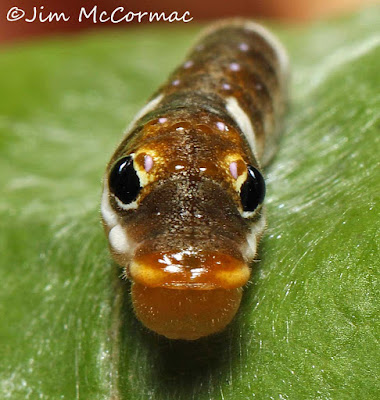The entrance to the main building at Stratford Ecological Center in Delaware County, Ohio (iPhone photo). I had the pleasure of visiting last Thursday afternoon, and speaking to the corps of volunteers that make this place tick. Or at least some of them - the volunteer ranks number about 180 people!
It was a great time, and I got to see and spend time with some wonderful people that I don't see nearly enough of. After my talk concluded, a bunch of us went outside for a stroll around the property to see what we could see. We didn't make it far. Basically, a nearly two hour loop that started at the sign in the photo, and ended there. We only made a big circle around the building, despite starting with more grandiose intentions!
But the walk's shortness was dictated by all the critters we saw in just that brief distance. I'll share some of them below.
First, a note about Stratford. The property encompasses about 236 acres, which includes meadows, woodlands, and wetlands. The photo above is from a vernal pool workshop back in 2011. Some of the best vernal pools remaining in central Ohio are on the property, and in spring they teem with salamanders, frogs, and myriad other life forms. In fact, early spring, at night, is usually the only time I ever see Stratford - when the amphibians are running. It was nice to spend some daylight hours there.
About 14,000 visitors annually come to learn about nature here, and a great many of them are school-aged. The site is worth its weight in gold for natural history education. The number of visitors just keeps increasing, demonstrating the value - need! - for places such as this, where people can get away from the hustle-bustle and into a tranquil biodiversity-filled place.
Consider visiting, and especially if you live in the central Ohio region, becoming a supporter. Read all about Stratford Ecological Center RIGHT HERE.
Anyway, I had every hope that we might make it to the woods with the vernal pools on our hike. But it was not to be - it seemed that every shrub and tree held some object of interest, and before we knew it, our time was up and we had only circled the administration building.
As soon as we gathered to head off, this handsome Potter Wasp, Monobia quadridens, flew in to entertain us as it nectared on a flower-potted Sedum. Its appearance was apropos, as I had just lectured on caterpillars and their role in the big-picture food web. Potter Wasps prey on caterpillars.
NOTE: While I usually do macro work with a full-frame Canon 5DS-R, the image above and those that follow were created with the crop-sensor Canon 7D II. It is a highly competent camera for macro, and about any other kind of shooting. The lens was the 100mm f/2.8L macro, and illumination was via the Canon 600 speedlite muffled by a Lumiquest softbox.
A "caterpillar-hunter wasp" Eremnophila aureonotata, gorges on nectar from an amazingly robust Hoary Mountain-mint, Pycnanthemum incanum. As you'll have deduced, the wasp also preys on caterpillars. David Hoy, Stratford's Development Director, eventually directed us over to this shrub of a mint. The sheer number of pollinators was beyond belief! Butterflies, wasps, bees, beetles - dozens and dozens of animals.
Close in on a Two-spotted Tree Cricket, Neoxabia bipunctata. It is one of the many "singers" that contribute to the insect soundscape of late summer and fall.
A Great Spangled Fritillary, Speyeria cybele, taps nectar from clover.
Back to the giant mountain-mint and a gorgeous Gray Hairstreak, Strymon melinus. Two of these suave little butterflies were working over the mint's flowers.
A rolled up leaf of a Spicebush, Lindera benzoin, gave away the bivouac's occupant. We carefully unrolled the leaf to admire the caterpillar of the Spicebush Swallowtail, Papilio troilus.
On the building's porch were some mustards of some sort being grown for food. And food they were, for some interesting caterpillars. This one is the larva of the Cabbage White butterfly, Pieris rapae. It's the ubiquitous little white butterfly of gardens and fields nearly everywhere.
Also noshing on the mustards were a number of these handsome tubular fellows, the Cross-striped Cabbageworm, Evergestis rimosalis. Like the Cabbage White, it is an import from foreign lands, but thrives here courtesy of our nonnative mustard plants. No matter its origin, the cat is quite handsomely marked.
Seeing the cabbageworms reminded me of a story from last year. We had a mini-conference on caterpillars in September 2015, based at the Eulett Center in the midst of the Edge of Appalachia Preserve in Adams County. We had hired a caterer to do the meals, and while we were looking at and photographing caterpillar livestock in the center while awaiting Saturday's lunch, he suddenly appeared at my side.
"Mr. McCormac" he whispered, "there's a problem with the salad. Worms are in the kale! It's taking us a while to pick them out." "Worms!" said I - "let me see these 'worms'"! Sure enough, Cross-striped Cabbageworms were in the kale and doing their best to eat it all before we had a crack at the green stuff. The photo above is of two of those very caterpillars.
Well, this was a wonderful opportunity and we brought out some of the salad-eating caterpillars for the group to admire. Everyone was pleased to see these handsome larvae and many photos were made. After the salad-stealing caterpillars had been removed from the greenery, the salads were consumed with no qualms or grumbling by anyone.
I think that our caterpillar conference attendees were probably the only group on earth that would have reacted favorably to this insect intrusion. And I'm sure the chef was pleased that we weren't upset, and probably also thought us to be weirdos of the highest order.











No comments:
Post a Comment